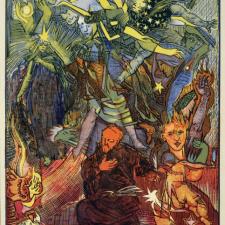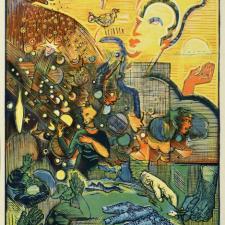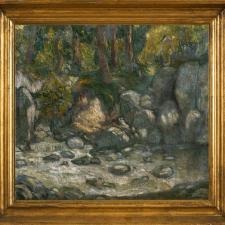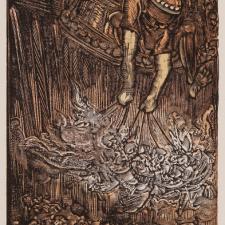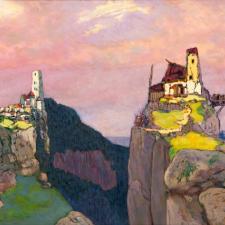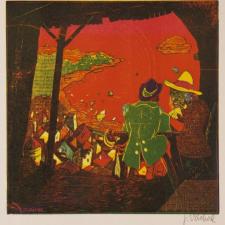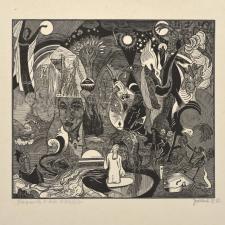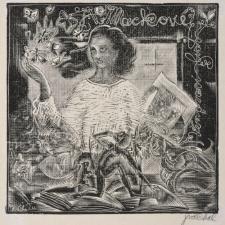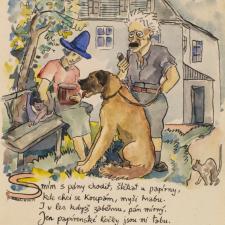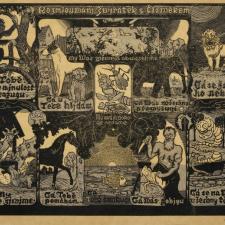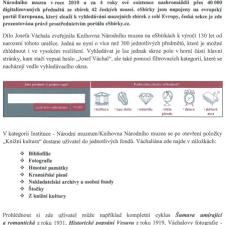Josef Váchal (1884–1969) was an artist who devoted his talents to a wide range of activities and whose work has yet to be fully appreciated. He drew, he painted, he carved sculptures and furniture, he etched, he created his own typeface, he bound books and he wrote them. However he saw himself primarily as a creator of woodprints, which he collated in the many original publications and books he produced.
Váchal was an artist of the book. He loved books and began reading, collecting, annotating and cataloguing them at a young age.
The books he created reflect his artistic versatility and his tendency to mix life and art, resulting in a work of art with a comprehensive concept. For most of his books he not only wrote the text but did the typesetting (later even using type he had cast himself), created the woodprint carvings and did all the printing work, and in the case of his most important projects he bound the books by hand himself. Váchal was not a creator of ‘beautiful books’, items much in demand in the Czech lands around the turn of the twentieth century. Nor had he any desire for his books to be ‘curiosities’, tucked away in the collections of provincial bibliophiles and as such only rarely and fleetingly looked through. He created his books for readers, and had no illusions about how many of them there would be. He consequently published just small print runs of his books, and made them adjustable, difficult to handle, and hard to understand. For the true reader of Váchal’s books, reading had to be a mystical experience, a process of being transported out of the precipitous march of time, which since his twenties Váchal had regarded as a deleterious consequence of an over-technologised world. A key feature of his books is the sophisticated way in which he worked with time. Readers who do not accede to the continuous deceleration of the reading process that results from the obstacles they are presented with as they go along cannot penetrate the mystery of the books and embark on the path of initiation. This initiation occurs as readers grow aware of the magical power of signs – and in this case typeface. Váchal approached typeface – and not just his own original typeface designs – as a living entity. Deliberately hard to read, the typeface in his books is made maximally visible. The absurdity, humour, irony and subversiveness that the texts themselves often convey only serve to reinforce the elusive and idiosyncratic character of the typeface. Váchal’s favoured method of typesetting a text without basing it on a manuscript not only resulted in numerous typos, grammatical errors, and violations against the aesthetics of typography, it also heightened the importance of the typeface itself, while the meaning of the text was a secondary outcome of the act of transcription.
Váchal always filled his books with a mystical energy, but over the course of his long life his personal views on the world changed dramatically. His interest in Christian and occult mysticism was periodically eroded by his blasphemous scepticism, which looked instead to the official authorities of heretical alternatives (Part 1 of the exhibition: Magic and Mysticism, Part 2: Alternatives). An ever present corrective in Váchal’s life and work was his caustic sense of irony, which he expressed through intertextual parodies, satire, and caricatures (Part 3: Intertextuality). This ironic detachment enabled Váchal to attain an increasingly freer outlook on humanity and art, a tendency that culminated in his later years which he spent in the village of Studeňany in Jičínsko, far from the centre of artistic developments. Váchal’s book projects were born out of complex interactions between literary and artistic inspirations, fantastical ideas and oftentimes wholly unexpected impulses. Váchal returned repeatedly to many of the book and literary motifs in his work over the course of his life. His book work cannot be categorised in a linear fashion, and its distinguishing features are, on the contrary, better captured as thematic chunks in a topography that encompasses Váchal’s essays, preparatory studies, and completed works. The installation of exhibits at this exhibition maps out the complex topography of Váchal’s individual book projects and project categories.
|
|






